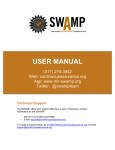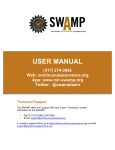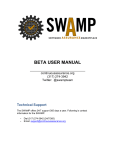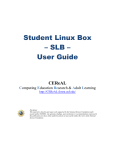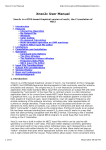Download USER MANUAL - Software Assurance Marketplace
Transcript
USER MANUAL (317) 274-3942 Web: continuousassurance.org App: mir-swamp.org Twitter: @swampteam Technical Support The SWAMP offers 24/7 support 365 days a year. Following is contact information for the SWAMP: • • Dial (317) 274-3942 (24/7/365) Email: [email protected] To create a support ticket, go to [email protected] . Technical Support ............................................................................................... 1 Preface ................................................................................................................. 3 Introduction to the Software Assurance Marketplace (SWAMP) .................... 3 Accessing the SWAMP ....................................................................................... 4 Registering with the SWAMP ......................................................................................................... 4 Password Requirements ................................................................................................................. 6 Forgotten Username/Password? ................................................................................................. 8 Signing in to the SWAMP ................................................................................. 10 Update Your SWAMP Account .................................................................................................... 11 Change Your Password ................................................................................................................. 12 Deleting Your SWAMP Account ................................................................................................. 14 Requesting Project Ownership ........................................................................ 16 Requesting a New Project ................................................................................ 16 Inviting Members to Your Project ............................................................................................ 21 Adding Your Software Package to the SWAMP ............................................. 24 Upload a Software Package ......................................................................................................... 25 Edit a Software Package ............................................................................................................... 29 Adding, Updating or Deleting a Software Package Version ......................... 32 View or Add a Version of a Software Package ...................................................................... 32 Delete a Software Package .......................................................................................................... 34 Software Package Sharing: Private, Public, or Protected ............................. 36 Managing Assessment Runs ........................................................................... 38 Add an Assessment Run ............................................................................................................... 38 Delete an Assessment Run .......................................................................................................... 40 Schedule a Run Request ............................................................................................................... 41 Run Request Scheduling Options ................................................................... 42 One-‐time Runs ................................................................................................................................. 43 Add a New Run Request ............................................................................................................... 44 Delete a Scheduled Run Request ............................................................................................... 50 Managing Assessment Tools........................................................................... 51 Adding Assessment Tools ............................................................................................................ 51 Editing an Assessment Tool ........................................................................................................ 53 Adding, Updating, or Deleting an Assessment Tool Version ....................... 55 View or Add a Version of an Assessment Tool ..................................................................... 55 Deleting a Tool .................................................................................................. 58 Assessment Tool Sharing: Private, Public or Protected ............................... 60 Protected Assessment Tools ...................................................................................................... 61 Glossary ............................................................................................................. 62 Version 20140122 Page 2 of 63 Preface This document guides selected users to successfully use the Software Assurance Marketplace (SWAMP). The SWAMP is state of-the-art software designed to serve as an open resource for software developers, assurance tool developers and researchers who wish to perform continuous assurance (CSwA) testing in a safe, secure environment. The SWAMP is funded by the Department of Homeland Security, and directed by academic experts in high-throughput computing, identity management, and security from the following organizations: the Morgridge Institute for Research, the National Center for Supercomputing Applications at the University of Illinois at Champagne-Urbana, the Center for Applied Cybersecurity Research at Indiana University and the University of Wisconsin-Madison. Introduction to the Software Assurance Marketplace (SWAMP) The SWAMP is a national, no cost resource for software assurance (SwA) technologies, used across research institutions, non-governmental organizations and civilian agencies and their communities as both a research platform and a core component in the software development life-cycle. It is our vision that widespread adoption of the SWAMP services will lead to a more secure and safer software ecosystem. The Software Assurance Marketplace (SWAMP) channels the mission of the Department of Homeland Security Science and Technology Directorate’s (DHS S&T) Cyber Security Division by: • • • Developing and leveraging technologies, tools and techniques to defend and secure current systems to better protect critical infrastructures against attacks from our adversaries, Facilitating technology transition through a marketplace approach where a collection of innovative technologies can be harnessed by the community, and Providing a collaborative research environment by which DHS customers, agencies of the U.S. government, academia, private industry and international partners can exchange technical and research ideas to help advance software security and quality improvements. The SWAMP may be used without cost by open-source, for profit, and non-profit organizations to test software for vulnerabilities and/or security risks. The Version 20140122 Page 3 of 63 accessibility of the SWAMP allows users at all levels to engage in the software development life-cycle. A user can upload his/her Software Package and/or Assessment Tool to the SWAMP for SwA testing. At launch, users will have access to over 100 Software Packages on the most popular Platforms (operating systems). The SWAMP protects your intellectual property and personally identifiable information. You control access to your Software Packages, Assessment Tools, and software Assessment Results. In the future, the SWAMP will offer the most frequently requested Software Packages, Software Assessment Tools, and Platforms. The SWAMP currently provides the following software assurance services: 1. For software written in one of the top three programming languages: 1. Java 2. C 3. C++ 2. For assessments using one or more most popular open-source static code analysis tools. Specifically: 1. FindBugs ~ On any supported Linux operating system supporting JVM 1.7.0_17 or greater 2. PMD ~ On any supported Linux operating system supporting JVM 1.7.0_17 or greater 3. Clang Static Analyzer ~ C/C++ for any supported Linux operating system 4. Cppcheck ~ C/C++ for any supported Linux operating system 5. Gcc ~ C++ compiler 3. For software that runs on one or more of these popular Platforms (operating systems): 1. Red Hat Enterprise Linux 6.4 32-bit 2. Red Hat Enterprise Linux 6.4 64-bit 3. Fedora 18 64-bit 4. Fedora 19 64-bit 5. Ubuntu 12.04.2 64-bit 6. Debian 7.0 64-bit 7. Scientific Linux 5.9 64-bit 8. Scientific Linux 6.4 64-bit Accessing the SWAMP Registering with the SWAMP In order to access the SWAMP, a user registration form must be submitted and will require some personally identifiable information. You may have more than one SWAMP user account. A different email address or login identifications will Version 20140122 Page 4 of 63 be needed for each additional user account that is created. You may use the same email address and personally identifiable information in additional SWAMP user accounts that was used in your initial SWAMP user account. Please note that your privacy is important to us. We will not provide your personal information to other organizations. Follow the steps below to register with the SWAMP. **Note: If at any time, SWAMP administration believes that your user account(s) is not being used appropriately, your account will be deactivated immediately by SWAMP administration. If this happens, contact SWAMP at [email protected] for any questions you may have, to request account reactivation, or to determine next steps to be able to access the SWAMP again. 1. Navigate to mir-swamp.org. Select Sign Up. 2. Read and accept the “Acceptable User Policy.” Version 20140122 Page 5 of 63 Notes: • All fields are required, with the exception of Street Address 2. • For the Email address field, only email addresses from institutions are allowed to use the SWAMP. For example, [email protected]. Freely available email accounts are prohibited, for example, Gmail, Hotmail, and Yahoo. • For the SWAMP Username field, the system generates an anonymous username to protect the user’s identity. The user can change the default username. The username may be recorded in log files. • For the Phone Number field the country code will be inserted when the user selects “country.” Type the area code, and the local number. Password Requirements A strong password is required to complete registration and for access to the SWAMP. The following are the minimum acceptable password requirements: • • • • • • At least ten characters. At least one upper case alphabetic character. At least one lower case alphabetic character. At least one digit. Symbols are encouraged. Do not use words found in the dictionary. Version 20140122 Page 6 of 63 The maximum password length is 200 characters. • 3. On the User Registration Form, type the requested information, and select Submit. 4. After submitting the registration form, you will be asked to verify your email address. Select OK. Version 20140122 Page 7 of 63 5. You will receive a verification email. Within the email follow the instructions to verify your email address. 6. You have now completed the registration process and can sign in to the SWAMP. Forgotten Username/Password? If you have forgotten your login information, navigate to the Welcome to the SWAMP screen and select Help, I forgot my password or Help, I forgot my username, depending on what information you need to reset. Resetting Your Password 1. Please enter your SWAMP User Name or Email Address. 2. Select Reset Password. 3. An email will be sent to the email address associated with your SWAMP account containing your new password. 4. Once you receive this email please sign in and reset your password. Version 20140122 Page 8 of 63 Resetting Your Username 1. Please enter your Email Address. 2. Select Request Username. Version 20140122 Page 9 of 63 3. An email will be sent to the email address associated with your SWAMP account with your current username. Signing in to the SWAMP At the Welcome to the SWAMP screen, sign in. If you are not yet a registered user of the SWAMP, you must first register. If you are registered, sign in with your username and password to access the SWAMP dashboard. Version 20140122 Page 10 of 63 Update Your SWAMP Account In the event that your personal information changes, you have the ability to update your personal information in your profile at any time. 1. Sign in to the SWAMP. 2. From the Home screen select My Account to make changes to your account, such as editing your profile. Select Edit Profile. Version 20140122 Page 11 of 63 3. On the Edit My Profile screen, make the desired changes and select Submit. Change Your Password In the event you would like a new password or you feel that your current password might have become compromised at any time, you have the option to change your password. Version 20140122 Page 12 of 63 1. To change your password, select Change Password. 2. See Password Requirements on page 6 for more information about creating a strong password. 3. Type the new password and select Submit. Version 20140122 Page 13 of 63 Deleting Your SWAMP Account If for any reason you would like to delete your SWAMP user account, you have the option to do so. By deleting your SWAMP user account, you will lose access to all information within in your SWAMP user account. The information will be stored in the SWAMP databases. If in the future, you wish to use the SWAMP again, you may register for a new SWAMP user account at any time. You will need to fill out the User Registration Form to create a new user account (pages 4-8). For access to your user account information, contact SWAMP at [email protected] 1. To delete your SWAMP account, from any screen select My Account. 2. On the My Profile screen, select Delete Account. Version 20140122 Page 14 of 63 3. You will receive a prompt asking you to confirm the deletion. Select OK to delete your account or Cancel to cancel your request. Version 20140122 Page 15 of 63 Requesting Project Ownership In an effort to ensure cybersecurity, users must Project Ownership status. Follow the steps below to become an approved Project Owner. Once approved, you may create projects and invite others to join your Project. Project Members can create Assessment Runs, schedule Run Requests, and view Assessment Results. You only need to request ownership of a project once. Requesting a New Project In an effort to ensure cybersecurity, users must request approval for their SWAMP Projects. Follow the steps below to request a Project. Once approved, you may invite others to join your Project. Project Members can create Assessment Runs, schedule Run Requests, and view Assessment Results. You only need to request ownership of a project once. After your initial project has been approved, you can create additional projects without approval from SWAMP administration. 1. On the Project Request screen select Add New Project. Version 20140122 Page 16 of 63 2. On the Project Registration Form screen, complete the following fields: Full name The full name is the long version of your Project’s name used in Project descriptions. Short name The Project short name or alias is the short version of your Project’s name and will appear in the sidebar. Affiliation Please include the company, university, or other organization with which your Project is affiliated. Assessment Results Viewer Choose the results viewer from the Description Please provide a description of your Project to help a SWAMP administrator approve your Project. Version 20140122 Page 17 of 63 3. Select Submit. Administrators of the SWAMP shall review the information provided in the Affiliation and Description fields to assess whether or not the information provided is appropriate and the intention of the user does not violate Acceptable Use Policy. A SWAMP administrator may contact the User requesting a new Project before arriving at a decision if the information provided is insufficient or incase the administrator needs more information about the project to correctly assess before approving. 4. The Project Request Submitted confirmation message appears. Select OK. Version 20140122 Page 18 of 63 5. Upon approval, you will receive a notification email. The project vetting process may take up to 2 business days, depending on the SWAMP staff’s ability to contact the person requesting the project. However, we make every effort to process Project Requests promptly. 6. To view Project request status, navigate to the Recent Events screen by selecting Home. Version 20140122 Page 19 of 63 Version 20140122 Page 20 of 63 Inviting Members to Your Project Project Owners may invite others to join to their Project. Invitees do not need to be current users of the SWAMP, but must register with the SWAMP to become a Project Member. Project Members are able to create Assessment Runs, schedule Run Requests, and view Assessment Results. A Project Owner is automatically a Project Member. 1. The Home screen lists your project under PROJECTS I OWN. 2. Select a Project you own. 3. Select the Members tab. Version 20140122 Page 21 of 63 4. The Project Members screen appears. **Note: SWAMP automatically lists the Project Owner’s name. 5. Select Invite New Members. Version 20140122 Page 22 of 63 6. From the Project Invitations screen, select Add Invitation. 7. Type the name and email of the person you are inviting. 8. Continue to Add invitations for any others for whom you want to join your Project. Individuals do not have to be registered users of the SWAMP to be invited, but must register if they are going to be a part of the project. 9. Select Send. Version 20140122 Page 23 of 63 10. You will receive a notification that invitations have successfully been sent to all new persons invited to join your Project. Adding Your Software Package to the SWAMP Version 20140122 Page 24 of 63 You may add and upload, edit or delete your Software Packages. A Software Package is a set of files containing related software or source code that needs to be assessed for vulnerabilities or insecurities. Upload a Software Package 1. To add your own Software Package, select Add New Package. 2. Complete the fields on the form. Name: Name of the Software Package. Version: Revision of the uploaded software. Build script: File to upload to SWAMP. Source path: A required field and is the name of the top level directory that is produced when the archive file is unarchived. Package type: This tells whether or not to invoke the build system to build the software from source code. From the dropdown menu choose C/C++, Java source code, or Java byte code. Build system: Name of the system to use to build the software. For C/C++, Make, Make+Configure, CMake+Make or other may be Version 20140122 Page 25 of 63 used. For Java source, Ant, Ant+Ivy or Maven could be chosen. This is an optional field. Advanced settings Configure path: The name of the directory relative to package-dir to change before running the configure command and is used only with C/C++ packages. This is an optional field. Configure command: The name of a command to configure the package before building. If undefined/empty, no command is run. This is only used for C/C++ packages. This is an optional field. Configure options: The name of options i.e. the arguments to pass to the configure command and is used only with C/C++. This is an optional field. Build path: It is the path to the directory related to the source path to change to before building. This is an optional field and is used for C/C++/Java. Build file: Used only with C/C++/Java source packages. It is the path to the build file related to the build path to use for the build systems except for the “Other” build command. For a build system type “Other”, the name of the file needs to be passed in the build options. This is only used with C/C++/Java source packages. This is an optional field. Build command: If a build system other than the ones listed above has to be used, “Other” from the build system menu has to be selected and a build command to execute the package needs to be provided. This is optional and is used only C/C++ packages. Build options: Name of the options and arguments to pass to the build command. Only for C/C++/Java source packages. This is an optional field. Build target: The name of the file to be created by the build process. This target is passed to the build command. It is used only with C/C++/Java source. This is an optional field. Description (public): to any user of the package. A text description of the package that is visible Description (private): A text description of the package that is only visible to the owner of the project. Version 20140122 Page 26 of 63 3. Select Submit to upload your Software Package. You will receive a notification once the upload is complete Version 20140122 Page 27 of 63 Version 20140122 Page 28 of 63 Edit a Software Package 1. From the Home screen select a Software Package to edit. Version 20140122 Page 29 of 63 2. On the Package Profile screen Select Edit Package. Version 20140122 Page 30 of 63 3. From this screen you can change the name of the Software Package. Type the revised name of the Software Package and select Save. 4. You will receive confirmation of the change. Select OK. Version 20140122 Page 31 of 63 Adding, Updating or Deleting a Software Package Version View or Add a Version of a Software Package From the Versions tab you can view your Software Package or add a new version of your Software Package. 1. Select the Versions tab, and then select Add Version. 2. From the Add New Version screen complete the fields on the form. Name: Name of the Software Package. Version: Revision of the uploaded software. Build script: File to upload to SWAMP. Version 20140122 Page 32 of 63 Source path: A required field and is the name of the top level directory that is produced when the archive file is unarchived. Package type: This tells whether or not to invoke the build system to build the software from source code. From the dropdown menu choose C/C++, Java source code, or Java byte code. Build system: Name of the system to use to build the software. For C/C++, Make, Make+Configure, CMake+Make or other may be used. For Java source, Ant, Ant+Ivy or Maven could be chosen. This is an optional field. Advanced settings Configure path: The name of the directory relative to packagedir to change before running the configure command and is used only with C/C++ packages. This is an optional field. Configure command: The name of a command to configure the package before building. If undefined/empty, no command is run. This is only used for C/C++ packages. This is an optional field. Configure options: The name of options i.e. the arguments to pass to the configure command and is used only with C/C++. This is an optional field. Build path: It is the path to the directory related to the source path to change to before building. This is an optional field and is used for C/C++/Java. Build file: Used only with C/C++/Java source packages. It is the path to the build file related to the build path to use for the build systems except for the “Other” build command. For a build system type “Other”, the name of the file needs to be passed in the build options. This is only used with C/C++/Java source packages. This is an optional field. Build command: If a build system other than the ones listed above has to be used, “Other” from the build system menu has to be selected and a build command to execute the package needs to be provided. This is optional and is used only C/C++ packages. Build options: Name of the options and arguments to pass to the build command. Only for C/C++/Java source packages. This is an optional field. Version 20140122 Page 33 of 63 Build target: The name of the file to be created by the build process. This target is passed to the build command. It is used only with C/C++/Java source. This is an optional field. Description (public): to any user of the package. A text description of the package that is visible Description (private): A text description of the package that is only visible to the owner of the project. Delete a Software Package 1. To delete a Software Package, navigate to the Package Versions screen. Select the X next to the version you wish to delete. Version 20140122 Page 34 of 63 2. You will receive a prompt asking you to confirm the deletion. Select OK to delete or Cancel to cancel your request. Version 20140122 Page 35 of 63 Software Package Sharing: Private, Public, or Protected You can share your Software Packages in one of three modes: • Private • Public • Protected Private: Only the Project Owner can see Software Packages. Public: Every SWAMP user can see Software Packages. Protected: The Project Owner can choose to share Software Packages in a Project with selected Members of that Project team. 1. Navigate to the Package Profile screen. Select Sharing. 2. The Package Sharing screen appears. Version 20140122 Page 36 of 63 3. Select the radio button to choose what level of access to the Software Package you wish to give Project Members. 4. Select Save. **Note: You do not have to be a Project Owner to upload a Package to the SWAMP. Version 20140122 Page 37 of 63 Managing Assessment Runs After an Assessment Run has been schedule, the Assessment Run will proceed through three states listed below: 1. Scheduled: The Scheduled state happens after you create a Run Request for the Assessment Run. 2. Running: The scheduled Run Request is executing the specified Assessment Run. 3. Done: The scheduled Run Request has completed and Assessment Results are available. **Note: You can view the details of each stage by selecting the current status under the Status field. Add an Assessment Run 1. Select Add Assessment. From each dropdown menu: 1. Choose a Software Package and its version. 2. Choose an Assessment Tool and its version. 3. Choose a Platform and its version. 2. Select Save. Version 20140122 Page 38 of 63 3. You will receive a confirmation message. Select OK. Version 20140122 Page 39 of 63 Delete an Assessment Run 1. To delete an Assessment Run, navigate to the Assessments screen. Select the X to the right of the Assessment Run you wish to delete. 2. Select OK to confirm that you wish to delete the Assessment Run. Version 20140122 Page 40 of 63 3. You will receive a confirmation that the Assessment Run has been deleted. Select OK. Schedule a Run Request 1. Select the Run Request tab and then select Add Run Requests. Version 20140122 Page 41 of 63 2. On the Add Run Requests screen, select the checkbox in front of the Run Request you wish to schedule, and then select Schedule Run Requests. Run Request Scheduling Options You can schedule Assessment Runs One-time or On a repeated schedule. Multiple runs can be scheduled simultaneously: • One-time: A One-time Run Request assesses a selected Software Package only once. • On a repeated schedule: With the repeated schedule option, the user could choose to schedule Assessment Runs on a regular basis like daily, weekly or monthly at a time selected. This feature is helpful when the user keeps editing the package regularly and wants to perform an Assessment Run with the same tool and on the same platform every time the package is modified or updated. Version 20140122 Page 42 of 63 One-time Runs 1. The schedule defaults to one-time on the Schedule Run Request screen. 2. If you want to schedule a recurrent Run Request, select Edit Schedules. 3. If you want to execute your Assessment Run as soon as possible, select Submit. Version 20140122 Page 43 of 63 Add a New Run Request 1. From the Edit Run Request Schedules screen, select Add Schedule. 2. On the Define Run Request Schedule screen, type a name for your schedule. For example, “Tuesdays at 8 a.m.” 3. Type a description. For example, “Run the assessment every Tuesday at 8 a.m.” 4. Select Add Request. Version 20140122 Page 44 of 63 Version 20140122 Page 45 of 63 5. In the Type dropdown menu select Daily, Weekly, or Monthly. • For Daily runs select the time. • For Weekly runs select the day and time. • For Monthly runs select the date and time. 6. Additional run times can be added to your Run Request schedule. Version 20140122 Page 46 of 63 7. Select Save. 8. You will receive a confirmation message. Select OK. Version 20140122 Page 47 of 63 Viewing Run Request Schedules and Results 1. View your scheduled runs on the Run Request Schedules screen. 2. Select the Runs tab to view the status of an Assessment Run. Version 20140122 Page 48 of 63 3. When an Assessment Run is done, select the Results tab to view the Assessment Results. Under the Details column select View to see the results. Version 20140122 Page 49 of 63 Example of detailed results from a run Delete a Scheduled Run Request 1. To delete a scheduled Run Request select the check box to the right of the run. Version 20140122 Page 50 of 63 4. You will be asked to confirm the deletion. Select OK to delete the Run Request or Cancel to cancel your request. 5. To view the Execution Record of the Assessment Run, from the Runs tab under the Status field select Done. Managing Assessment Tools A SWAMP user may upload Assessment Tool(s) he/she has developed and then test the Assessment Tool against publically available Software Packages or personally uploaded Software Packages. Adding Assessment Tools 1. From left pane on any screen, select Add New Tool. 2. Complete the fields on the form. Name: File: Version: Tool path: Deployment command: Description (public): Description (private): Version 20140122 Name of the Assessment Tool. File to upload to SWAMP. Revision of the uploaded Assessment Tool. The path to the Assessment Tool executable. The command used to install the Assessment Tool. Description of the Assessment Tool to those who have access to it. Private description and comments for the Owner of the Assessment Tool. Page 51 of 63 3. Select Submit to upload your Assessment Tool. You will receive a notification once the upload is complete. Version 20140122 Page 52 of 63 Editing an Assessment Tool If you need to rename an Assessment Tool, you may do so here. If the name of an Assessment Tool is misspelled or to accommodate a new brand name you can change its spelling. 1. From the left pane of any screen select an Assessment Tool to edit. Version 20140122 Page 53 of 63 2. On the Tool Profile screen select Edit Tool. 3. From this screen you can change the name of the Assessment Tool. Type the name of the Assessment Tool and select Save. 4. You will receive confirmation of the change. Select OK. Version 20140122 Page 54 of 63 Adding, Updating, or Deleting an Assessment Tool Version View or Add a Version of an Assessment Tool From the Tool Profile screen you can view your Assessment Tool or add a new version of your Assessment Tool. Follow the steps below to add a new version of your Assessment Tool. 1. Select Versions. Version 20140122 Page 55 of 63 2. On the Tool Versions screen select Add Version. Version 20140122 Page 56 of 63 3. On the Add New Tool screen complete the fields on the form and select Submit. Name: File: Version: Tool path: Deployment command: Description (public): Description (private): Name of the Assessment Tool. File to upload to SWAMP. Revision of the uploaded Assessment Tool. The path to invoke the Assessment Tool. The command to install the Assessment Tool. Description of the Assessment Tool to those who have access to it. Private description and comments for the Owner of the Assessment Tool. Version 20140122 Page 57 of 63 Deleting a Tool 1. To delete an Assessment Tool, from the left pane on any screen under TOOLS I OWN, select an Assessment Tool to delete. Version 20140122 Page 58 of 63 4. On the Tool Profile screen select Delete Tool. 5. You will receive a prompt asking you to confirm the deletion. Select OK to delete the Assessment Tool or Cancel. Version 20140122 Page 59 of 63 Assessment Tool Sharing: Private, Public or Protected You can share your Software Packages in one of three modes: • Private • Public • Protected Private: Only the Project Owner can see Assessment Tools. Public: Every SWAMP user can see Assessment Tools. Protected: The Project Owner can choose to share Assessment Tools in a Project with selected Members of that Project team. Navigate to the Tool Profile screen and select Sharing. Version 20140122 Page 60 of 63 Protected Assessment Tools 1. Select the radio button to choose what level of access to the Assessment Tool you wish to give Project Members. 2. Select Save. Version 20140122 Page 61 of 63 Glossary Assessment Run: Specifies one Tool to assess one Software Package on one operating system Platform. Assessment Tool: An Assessment Tool analyzes a Software Package to find weaknesses that could lead to security vulnerabilities. One person owns an Assessment Tool. Continuous Software Assurance: A process that affirms software functions as intended, free from vulnerabilities intentionally or unintentionally inserted into the code. This is achieved through continuous assessments. Execution Record: Displays statistics about the scheduled Assessment Run. Owner: A User who owns a Project, Assessment Tool, and/or Software Package. Platform: The operating system environment in which an Assessment Run occurs. Project: A person or group of people working together for a common purpose, for example to create better assessment tools, and/or to mitigate weaknesses in Software Packages. Project Member: A person who has accepted an invitation to join a SWAMP project. Project Members are able to create Assessment Runs, schedule Run Request, and view Assessment Results. Run Request: A request to execute one or more Assessment Runs as soon as possible after the requested time. Project Members can schedule Run Requests to occur daily, weekly, or monthly. Members can schedule Run Requests that are a combination of daily, weekly, or monthly times. Software Package: A software component or system used by others. User: A person granted permission to belong to the Software Assurance Marketplace. A SWAMP user must be a member of a project to use Assessment Tools, Platforms, and view Assessment Results. Version 20140122 Page 62 of 63 Table 1. Compatibility of Platforms and Tools Tools PMD Platforms Red Hat Enterprise Linux 6.4 32-bit Red Hat Enterprise Linux 6.4 64-bit Fedora 18 64-bit Fedora 19 64-bit Ubuntu 12.04.2 64-bit Debian 7.0 64-bit Scientific Linux 5.9 64-bit Scientific Linux 6.4 64-bit FindBugs Cppcheck Gcc Clang Static Analyzer **Note: It is important to select the correct Platform when running an assessment. Selecting the incorrect Platform generate false results. Version 20140122 Yes Yes Yes Yes Yes Yes Yes Yes Yes Yes Yes Yes Yes Yes Yes Yes Yes Yes Yes Yes Yes Yes Yes Yes Yes Yes Yes Yes Yes Yes Yes Yes Page 63 of 63 Yes Yes Yes Yes Yes Yes Yes Yes































































